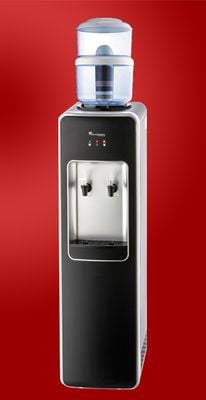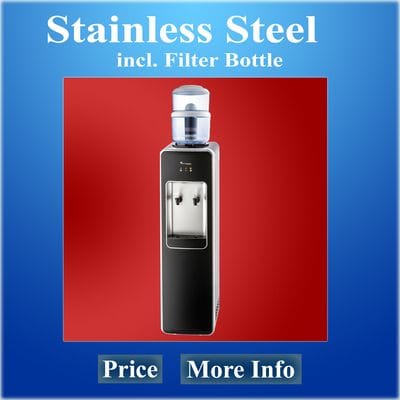Water Dispenser Nambour
Great tasting water made from your own tap with Prestige Water Dispenser Nambour
 Benchtop Water Dispenser Nambour:
Benchtop Water Dispenser Nambour: ![]()
 Floor Standing Water Dispenser Nambour:
Floor Standing Water Dispenser Nambour: ![]()
 Exclusive Water Dispenser Nambour:
Exclusive Water Dispenser Nambour: ![]()
Why you and your baby should drink water from a water dispenser Nambour
Water is essential for your body. And so much more than a thirst quencher. Calculate how much water you should drink. Discover all the benefits of water for you and your baby. During pregnancy and afterwards.
Water from a water dispenser Nambour, the most important building block of your body
Your body needs water. You can soak for weeks without food, but not without water. Do you know why? 7 Ways to influence your energy intake.
Water is more than just a thirst quencher
It fulfils a whole bunch of other important functions in the body, such as:
- as a building block of and between the body cells.
- as a component of the moisture between the tissues.
- as a lubricant in the contraction of the muscles.
Water also ensures that your body temperature remains constant. Your baby is very sensitive to temperature fluctuations and needs water to keep his body temperature constant.
As an adult, you lose about 2.5 litres of water a day
Most of the water leaves your body by peeing, another part is absorbed by your intestines and the rest you lose by sweating and by breathing. You must, of course, also add to what you lose. If you are pregnant, you also need to add a particle for your baby. So replace the water loss by drinking from a water dispenser Nambour.
The kidneys separate 50% of the water
The rest of the water in the body disappears through the stool, the skin and the lungs.
Drink plenty of water during your pregnancy
If you are pregnant, drinking water is even more important than usual. Both for you and for your future baby.
After 25 weeks, a baby has 90% water
The child in your stomach is still developing and you share everything with him. Even at birth, the kidneys and the digestive system are not yet fully mature. During your pregnancy, you must therefore pay close attention to what you eat and drink.
Water renews the amniotic fluid of your baby
At the end of your pregnancy, you have about one litre of amniotic fluid in your stomach. Great tasting water from a water dispenser Nambour. This is completely renewed every three hours by the water that is supplied by your organism. Water as a solution for pregnancy ailments. Drinking water prevents or relieves a lot of pregnancy discomforts:
Constipation
During your pregnancy, your placenta makes large amounts of progesterone. Flue and drinking water. Anti-Colds and drinking water. That hormone slows the intestinal transit. So eat a lot of fibre (fruit and vegetables) and drink a lot of water. That promotes the functioning of your intestines. Did you know that constipation is also the main cause of hemorrhoids during pregnancy? Being pregnant means more risk of inflammation of the urinary tract. Your uterus exerts pressure on the ureters and the urine transport decreases. This gives bacteria more chance. Drinking a lot of healthy water from a water dispenser Nambour - and thus peeing - ensures that bacteria are quickly drained.
Pregnancy edema
Your body will retain more fluid if you are pregnant. Drink as much as possible and opt for low-salt water. This way the moisture disappears faster.
Prestige Water Cooler Nambour, Water Dispenser Nambour, Water Filter Nambour
Aroona, Bald Knob, Balmoral Ridge, Battery Hill, Beerburrum, Beerwah, Bells Creek, Birtinya, Bokarina, Booroobin, Bribie Island North, Buddina, Caloundra, Caloundra West, Cambroon, Conondale, Coochin Creek, Crohamhurst, Curramore, Currimundi, Diamond Valley, Dicky Beach, Elaman Creek, Glass House Mountains, Glenview, Golden Beach, Harper Creek, Kidaman Creek, Kings Beach, Landsborough, Little Mountain, Maleny, Meridan Plains, Minyama, Moffat Beach, Mooloolah Valley, Mount Mellum, North Maleny, Palmview, Parrearra, Peachester, Pelican Waters, Reesville, Shelly Beach, Warana, Witta, Wootha, Wurtulla, Alexandra Headland, Belli Park, Bli Bli, Bridges, Buderim, Burnside, Chevallum, Coes Creek, Coolabine, Cooloolabin, Coolum Beach, Cotton Tree, Diddillibah, Doonan, Dulong, Eerwah Vale, Eudlo, Eumundi, Flaxton, Forest Glen, Gheerulla, Highworth, Hunchy, Ilkley, Image Flat, Kenilworth, Kiamba, Kidaman Creek, Kiels Mountain, Kulangoor, Kuluin, Kunda Park, Kureelpa, Landers Shoot, Mapleton, Marcoola, Maroochy River, Maroochydore, Mons, Montville, Mooloolaba, Mount Coolum, Mountain Creek, Mudjimba, Nambour, Ninderry, North Arm, Obi Obi, Pacific Paradise, Palmwoods, Parklands, Peregian Beach, Peregian Springs, Perwillowen, Point Arkwright, Rosemount, Sippy Downs, Tanawha, Towen Mountain, Twin Waters, Valdora, Verrierdale, West Woombye, Weyba Downs, Woombye, Yandina Creek, Yandina, Yaroomba, Castaways Beach, Noosa Heads, Noosaville, Sunrise Beach, Sunshine Beach, Tewantin, Como, Marcus Beach, Noosa National Park, Noosa North Shore, Peregian Beach, Teewah, Black Mountain, Boreen, Boreen Point, Cooran, Cooroibah, Cooroy, Cooroy Mountain, Cootharaba, Doonan, Eerwah Vale, Federal, Kin Kin, Lake Macdonald, Pinbarren, Pomona, Ridgewood, Ringtail Creek, Tinbeerwah.





